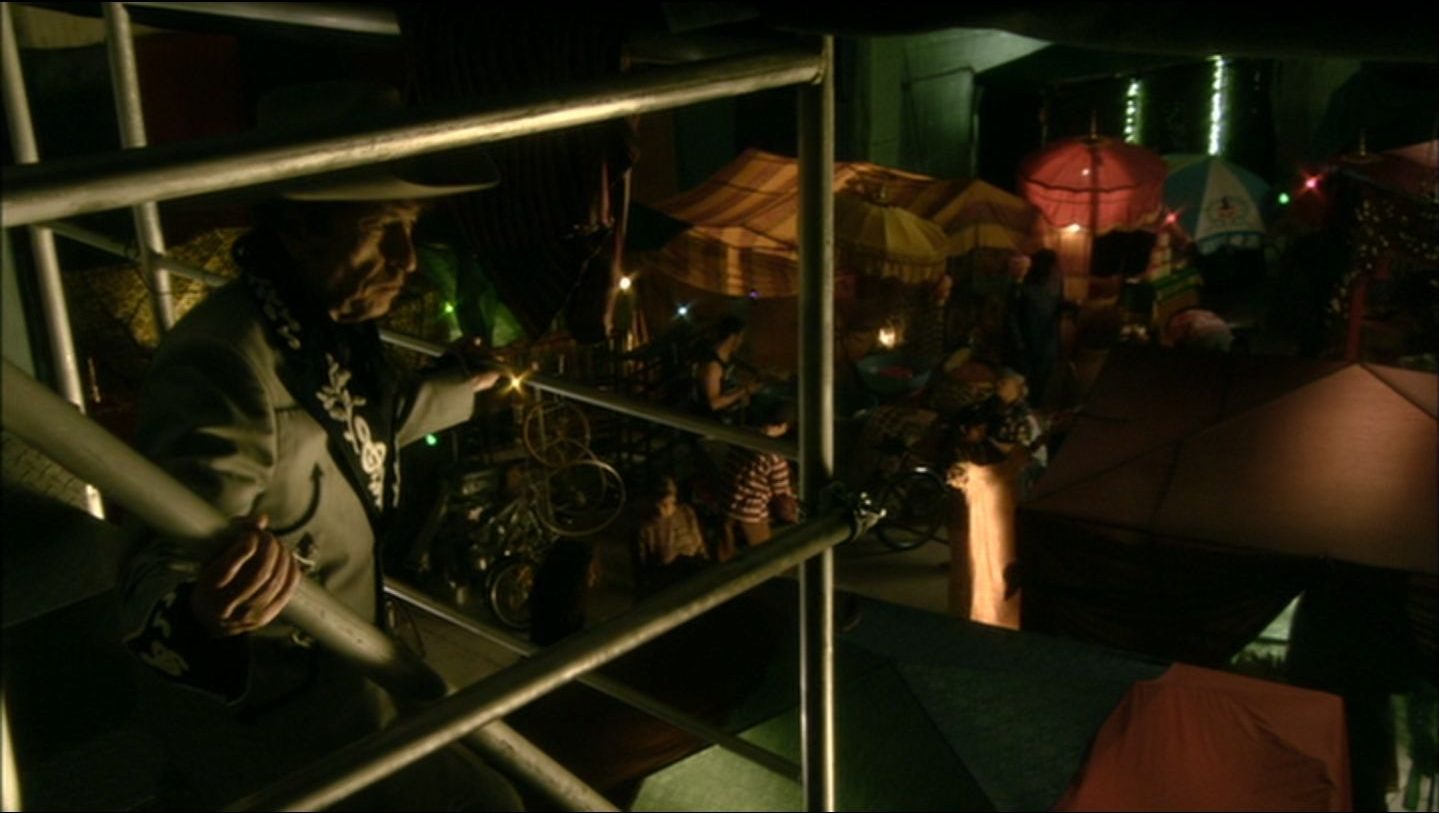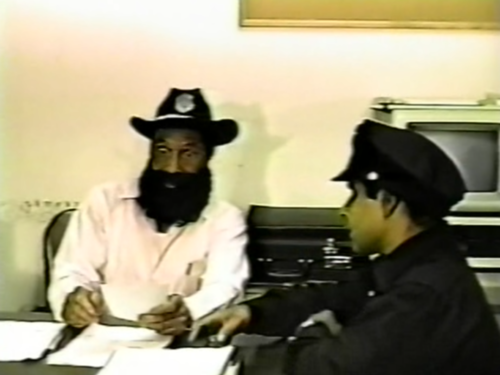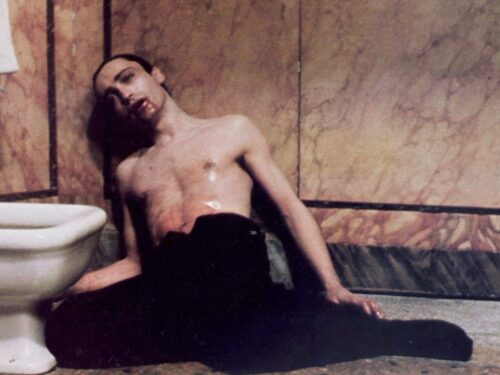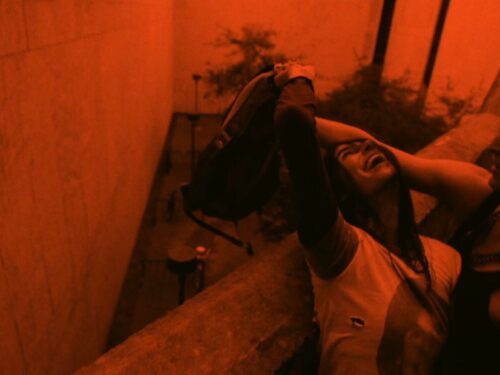On the eve of its 20th anniversary, ‘Masked and Anonymous’ remains a darkly prophetic and unjustly overlooked milestone for Dylan
In the late 1990s, Bob Dylan staged one of his many comebacks with Time Out of Mind (1997). He then put out the instant classic “Love and Theft” in 2001. In 2004, he published the best-selling first installment of his memoirs, Chronicles Volume 1. The film Masked and Anonymous premiered in the middle of all of this acclaim in 2003. The film is a strange picaresque narrative starring Dylan as the blues-singing son of a dying dictator set during a civil war in a dystopian future America; unlike the rest of his work in this stretch, it was panned by nearly every mainstream reviewer who saw it.
To be fair, Masked and Anonymous is an incredibly ambitious work and an often disorienting experience. Compared to the tales of Dylan’s oft-romanticized New York folk days presented in Chronicles, or the complex, but entirely accessible, compositions of songs like “Not Dark Yet” and “Summer Days,” Masked and Anonymous was definitely harder to digest than Dylan’s other projects at the time. Featuring an endless collection of A-list stars (Jeff Bridges, Penelope Cruz, Angela Bassett, Jessica Lange) and master character actors (John Goodman, Bruce Dern, Tracey Walter), the film defies expectations at every turn. Avoiding the types of star-moments and technical polish one might assume from a production with such a cast, Masked and Anonymous is instead rough and loose. In fact, it is often downright messy, which is far from a downside, and perhaps its most brilliant aspect. The film presents humanity as an absurd masquerade in which the ghosts of murdered blackface performers materialize in costume to paraphrase the Book of Matthew, and Abe Lincoln and Gandhi are not just united together onscreen, but are paraded through a cramped backstage trailer as sideshow performers for a rock concert. While the film has its supporters, it appears to be remembered — or perhaps more appropriately, when it is remembered — as a curio reserved for Dylan’s most ardent fans, and for receiving a hateful half-star review from Roger Ebert.
But the general lack of appreciation for Masked and Anonymous should come as no shock for anyone familiar with Dylan’s history as a filmmaker. The Nobel-Prize-winning songwriter has lived many lives and worn many hats, masks, and wigs over the decades. But it can safely be said that nothing in his creative output has been more divisive than his filmmaking. His first two efforts from behind the camera, Eat the Document (1972) and Renaldo and Clara (1978), are both complex art films composed from footage taken during two legendary concert tours (his 1966 run through England and the Rolling Thunder Revue of 1975, respectively) that have perplexed viewers for half a century. The strangeness of Dylan’s best music not only carries over into the cinematic form, but is heightened through unconventional narrative structures, bizarre editing rhythms, and outlandish juxtapositions of sound and image. These films blend improvised dramatic scenes with documentary footage — some caught on the fly and some clearly staged — and slip into dreams and flashbacks without notice. They are often dizzying in their ellipticity, particularly Renaldo and Clara, which runs just under four hours in length. It weaves together so many different tangents and half-plots that anyone approaching it in a basic Bob McKee story sense is advised to turn away before the first song has finished.
Not one of the three features on which Dylan acted as director and/or writer have been spared from accusations of pretension and vanity by reviewers. In recent years, there have been some incredibly thoughtful critical reevaluations of Dylan’s films, but the contemporary drubbings Dylan took from behind the camera clearly stung. To this day, Eat the Document and Renaldo and Clara remain out of circulation and are available solely in pirated or bootlegged form.
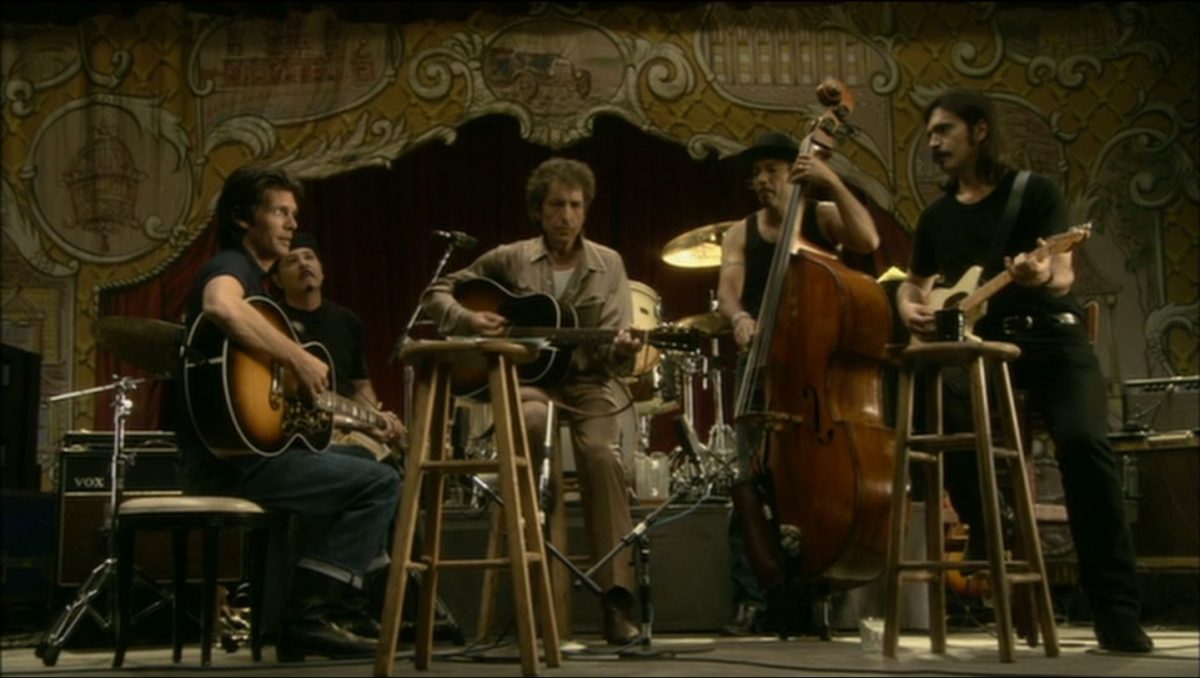
Arriving decades later, Masked and Anonymous may have a more clearly defined narrative than Dylan’s previous films, but do not take that to mean it is in any way more conventional. The original idea for the project came about when Dylan reached out to Larry Charles (the Seinfeld writer and soon-to-be director of Borat) about collaborating on a comedy show for HBO. Dylan was to play a Buster Keaton-esque stoneface passing through various environments and interacting with absurd characters along the way. Dylan lost interest in the show as soon as HBO offered to fund it, so he and Charles instead began work on a film script (under the pseudonyms Sergei Petrov and Rene Fontaine). Dylan would bring in notes and fragments of ideas, and Charles would help sort through them, flesh them out, and arrange them into a screenplay that he would direct.
This project eventually morphed into a film set during a civil war in a semi-fictionalized future America. A sleazy concert promoter named Uncle Sweetheart (John Goodman) is trying to stage a benefit show for the corrupt government’s television network. When none of the big names he and his producer, Nina Veronica (Jessica Lange), try to hire agree to perform, they scrape up Jack Fate (Dylan), a once-important singer-songwriter who has been in prison for years. Sweetheart arranges for his release and hires a Jack Fate tribute band to back him for the event. Fate makes the long journey to the city, calls in his sidekick Bobby Cupid (Luke Wilson), and begins rehearsals inside a compound surrounded by armed guards and barbed wire fences while the world devolves further into violence and uncertainty.
Meanwhile, a journalist named Tom Friend (Jeff Bridges) is sent to cover the event when word gets out that Fate will be performing. We learn that Fate is the son of the deathbed-ridden dictator (played by Vanishing Point director Richard C. Serafian). Fate’s exile was spurred by his being caught with his father’s mistress (Angela Bassett) as a young man. Now, his power-hungry half-brother of sorts (Mickey Rourke) sits in waiting to take control of the country.
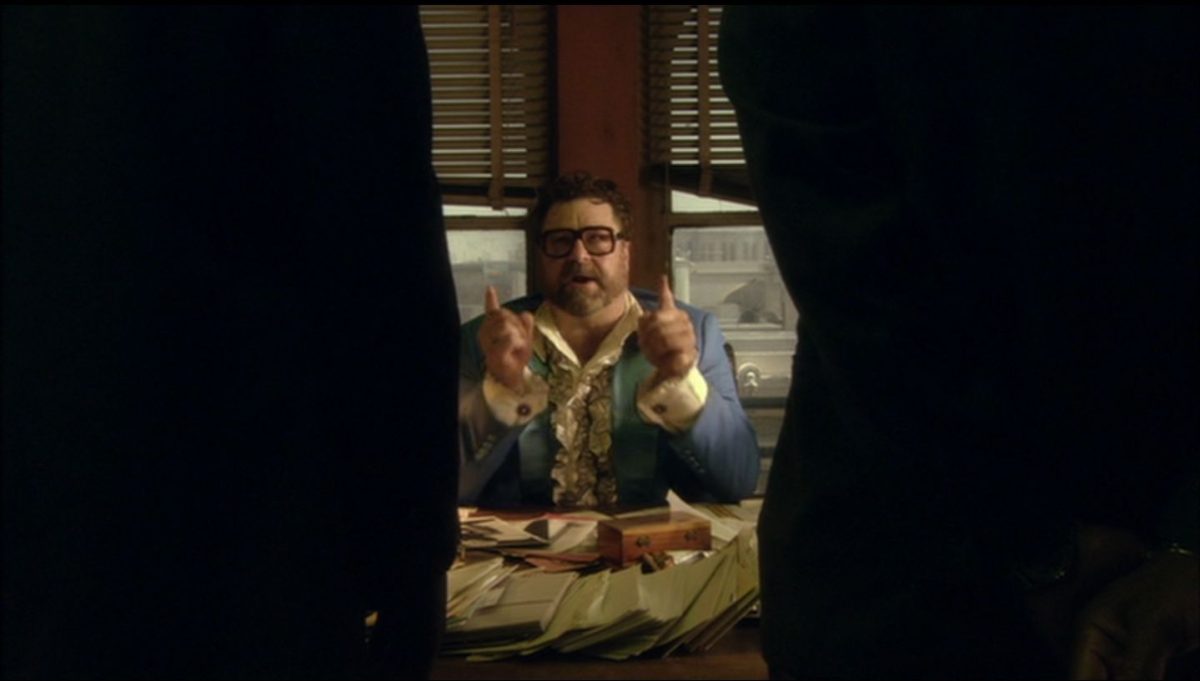
From the start, Masked and Anonymous places us between two vastly different understandings of cinematic reality. The film opens with a montage mixing stock news footage of civil unrest and military activity with naturalistic shots of homeless citizens on the streets of a thinly disguised Los Angeles. We are then guided into Uncle Sweetheart’s office where, while being confronted by two secret policemen sent to collect dues, he shouts, “Are you aware, gentlemen, that this is all a play?” Dylan and Charles immediately make it clear that this is a film daring to have it both ways: it is at once “documentary-like” in its shooting style, while brazenly declaring an allegiance to “all the world’s a stage” artificiality. Sweetheart’s office is our entry into the nearly psychedelic backstage vision of a social and political world in which everything seems to be at odds with itself. “Truth” matters little here. Everything has multiple meanings and figures like Sweetheart spin words out of any controllable meaning-making function in order to benefit themselves. Everyone is playing a part and trying to turn situations in their favor so they can live to swindle another day. When no one thinks anyone can be trusted, they all put on more elaborate performances and hide in the plain sight of their own interests.
Beyond the studio, Fate encounters an array of characters trying to make sense of it all. They run the gamut from a radical soldier (Giovanni Ribisi) haunted by an inability to recognize which side of the war he really stands on, to a flamboyant animal wrangler (Val Kilmer, who nearly steals the entire movie with only a few minutes of screen time) who performs a sweeping monologue about mankind’s eternal identity crisis and violent instincts. He establishes analogies between every era of history, from the Aztecs to contemporary corporate America.
The narrative of this film is so devilishly intricate that it is no wonder unimaginative reviewers wrote it off as a vanity project; it is essentially a Dylan song brought to life with the man himself at its center. On one level, Masked and Anonymous is a prism of self-referentiality. All of Dylan’s films are very much about “Bob Dylan;” They explore his persona and the monolithic, prophet-like role that has been constructed around him — a role he is always in the process of complicating. Eat the Document, for instance, was conceived as an “anti-documentary,” according to C.P. Lee, author of Like a Bullet of Light: The Films of Bob Dylan (2000), which Dylan “hoped would contribute to a new anti-mythology” of himself. But in Masked and Anonymous, the self-referential aspects are overwhelming and have seeped into the very fabric of the film: The soundtrack is composed entirely of Dylan songs covered by an array of international artists; the government-controlled television network’s program schedule is slated with shows like Empire Burlesque, Jokerman, and It’s Alright ‘Ma. Certain characters are clearly modeled upon figures from Dylan’s past — most obviously Goodman’s Uncle Sweetheart, whose appearance takes more than a few cues from Albert Grossman, Dylan’s infamous manager throughout the 1960s. “Bob Dylan” has saturated not only the formal dimensions of the film, but every aspect of the culture that the characters occupy within the film, earning tributes and suffering from corrupted and cheapening institutionalized appropriation.
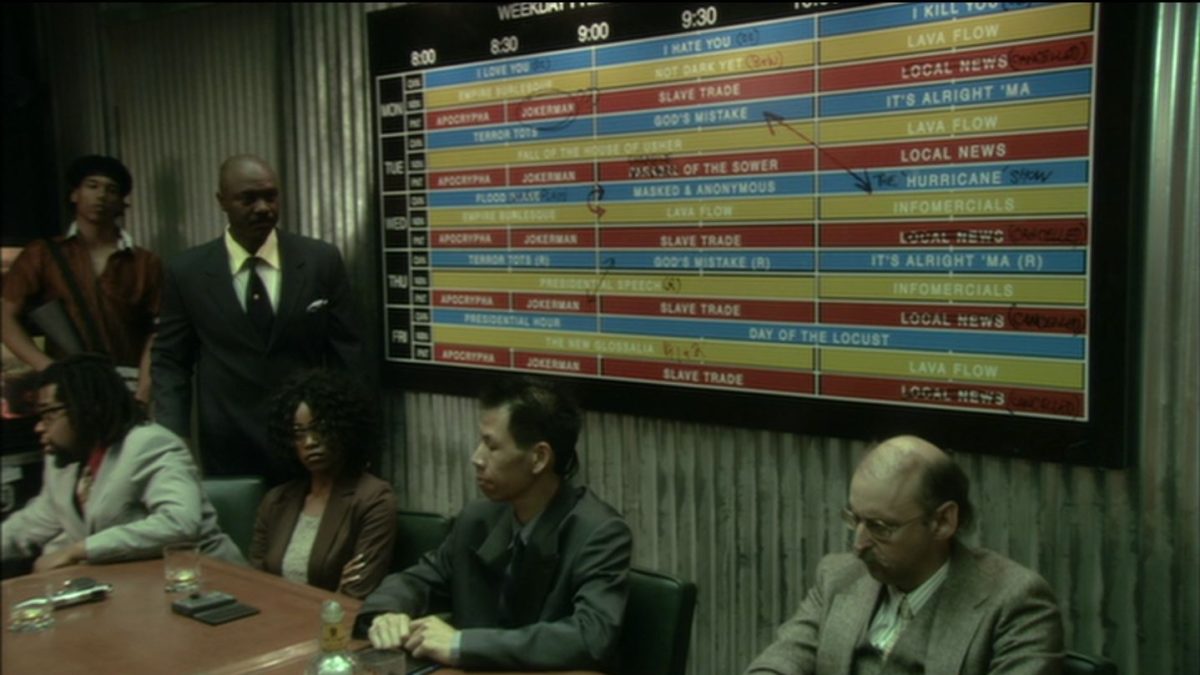
It was Jeff Bridges’ idea for Tom Friend to mimic Dylan’s wardrobe in various ways throughout the film. At the beginning, he matches Jack Fate’s prison attire (sweats and a hoodie) and later, while confronting Fate in person, he sports the style of suit and sunglasses that Dylan famously wore during his mid-’60s electric phase. Friend’s questions feel like they are aimed not just at Fate, but at Dylan himself as well. He functions as a stand-in for every journalist, fan, and critic who ever expected the real Dylan to represent an entire generation or tried to pigeonhole him as an icon or a phony. “You’re supposed to have all the answers,” quips Friend as he questions Fate/Dylan about why he skipped out on cultural milestones such as Woodstock and accuses him of being vain and self-important. Friend, down to his facsimile attire, is working to freeze Fate and turn him into a cultural monument of the past, to hold him responsible for a generation’s failings and missed opportunities. It is telling that Dylan chooses to remain mostly silent in the presence of the journalist — a far cry from the combative persona on display in Dylan’s most famous film project, D.A. Pennebaker’s Dont Look Back (1967).
Related: The Music Of Bad Timing: Joel And Ethan Coen’s Inside Llewyn Davis (2013) by Steve Collins
But on another level, Masked and Anonymous is reflective not just of Dylan’s own life and times, but of all time. It’s often staged as if past and present are taking place all at once and heading towards a perpetually bleak horizon. His best songs have always been dense, with sprawling and kaleidoscopic structures that are packed to the brim with allusions. Their meanings shape-shift with each new phrase. Connections to Herman Melville’s work have been drawn — often sketched and encouraged by Dylan himself — because, like the great American novelist and poet, Dylan’s intricate layerings of historical allusions, quotations, and echoes of preexisting works of art and literature elevate a great deal of his work into the realm of cosmic tragedy. For Dylan, there is no escaping the influences or injuries of the past, and they are bound to be repeated. Breaking from whatever elemental forces tether us to humanity’s most self-destructive cycles remains a mysterious and potentially impossible feat. (It is worth noting that Masked and Anonymous shares particularly striking structural and tonal similarities to Melville’s 1857 novel The Confidence-Man: His Masquerade, in which a group of passengers aboard a Louisiana steamship swindle, cheat, debate moral questions, and try to win each other’s trust during a journey toward the auction blocks of New Orleans.)
Themes of civil war and revolution were common in all of Dylan’s work at the time of Masked and Anonymous. Portions of Chronicles relate quite provocatively not only to thematic concerns, but to deeper stylistic dynamics established in Masked and Anonymous. The book includes a discussion of Thucydides’ History of the Peloponnesian War (which Dylan incorrectly refers to as The Athenian General in a passage rife with other incorrect book titles and faulty synopses of classic literary works). The quotation to which Dylan refers appears just after the outbreak in 427 B.C. of the Civil War in Corcyra. “In times of peace and prosperity cities and individuals alike follow higher standards,” writes Thucydides,
“But war is a stern teacher… it brings most people’s minds down to the level of their actual circumstances… The sufferings which revolution entailed upon the cities were many and terrible, such as have occurred and always will occur, as long as the nature of mankind remains the same…. Words had to change their ordinary meaning… Reckless audacity came to be considered the courage of a loyal ally… ability to see all sides of a question, inaptness to act on any.”
Dylan responds, “It was written four hundred years before Christ and [Thucydides] talks about how human nature is always the enemy of anything superior… It’s like nothing has changed from his time to mine.”
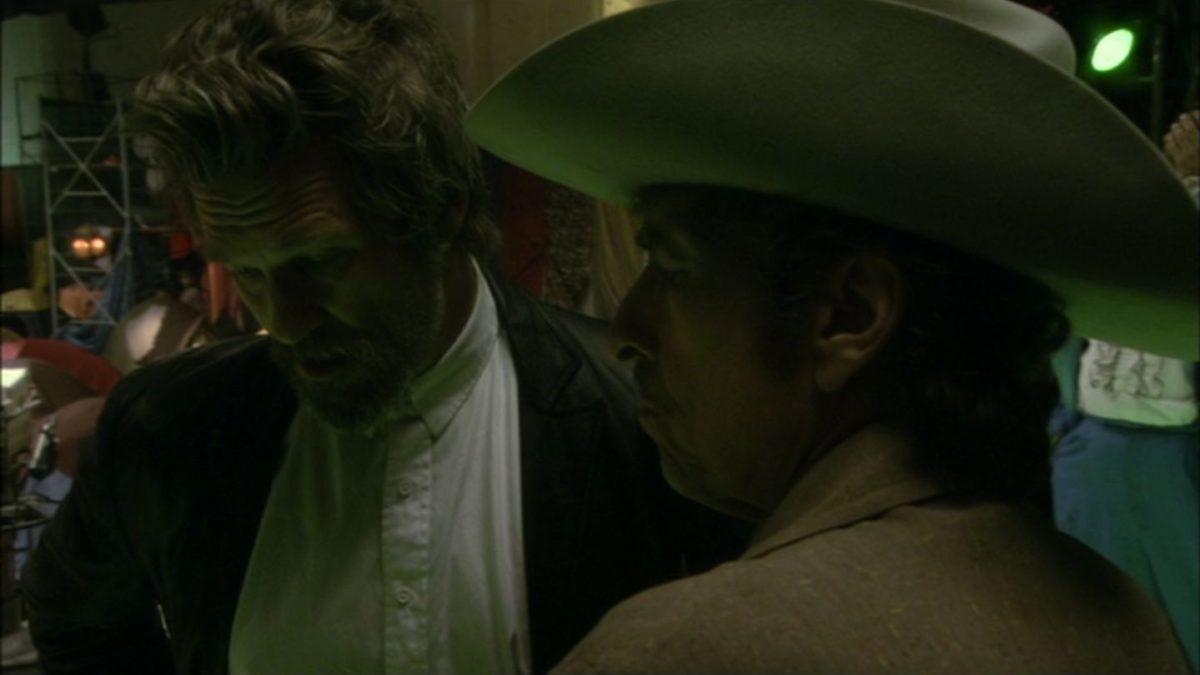
Setting Masked and Anonymous during a period of civil war allows Dylan to build an atmosphere of similar extremes. In the world of the film, character stretches into caricature. The most inhumane actions, such as rebels gunning each other down in the middle of the road, will leave a crowd unphased, while extravagant dialogue weighed with Biblical import and Shakespearean excesses appear completely natural alongside all the violence. The radical language of the past has been commandeered and repurposed by the establishment for deceptive means; The government requests that Fate perform once-rebellious protest songs like MC5’s “Kick Out the Jams” at their benefit show to create the illusion of progressive change. Thucydides further echoes through some of the dialogue (Ribisi’s confused radical states, “I just knew you had to take sides”) and in the styles of language used within the film.1 Notice also how the dystopian atmosphere allows Dylan to explore another perspective on history’s less reputable ways of “immortalizing” the geniuses of the past. For instance, a few of the buildings in the film are named for historical figures. Some match the current atmosphere of corruption and deceit, like the Midas-Judas Building where Uncle Sweetheart holds office. Others appear to be tributes from a distant past, where genius and beauty were appreciated and esteemed, that have warped under the violence of the moment. One such example is the Whitman Hotel where Fate stays once he reaches the city. Instead of tributes being made to the namesake poet, the hotel features a lobby in which all the artwork has been covered up with sheets, and allusions to Whitman’s long, listing free verse style come in the bastardized form of the desk clerk’s (Tracy Walters) manner of rattling off the many options for female prostitutes offered by the hotel (“We have slave women, immigrant women, western women, southern women, modern women” and so on.) The appropriation we have seen taking place with the still-living legend of Dylan/Fate and his music on the television networks and elsewhere continues to plague the dead poets before him.
Dylan’s stoic approach to playing Fate was criticized by nearly everyone who reviewed the film. Many deemed his performance stiff and accused his approach to dialogue of evoking “the language and philosophy of Chinese fortune cookies.” Sure, Dylan’s performance lacks the charisma of Goodman or the nuances of Bridges. His character is rather inactive when faced with the accusations hurled at him by Friend, and he avoids involving himself with much passion in the mostly greed-driven conflicts of the people around him (at least until the film’s final minutes). But these choices are not without purpose. Fate stands as a force of contrast to the verbose and extravagant figures who have allowed their identities to be swept up into the chaotic theater of impending armageddon. He speaks plainly, lacking, to steal a phrase from Mr. Melville, the “sinister dexterity” of the Uncle Sweethearts and the political and business-minded figures that surround him. Even when describing vivid dreams of walking through fire to the confused radical on the bus — who claims he can only find peace when his dreams become his reality — Fate makes it clear he sees no worth in looking for any sort of meaning beyond the surface of things. There is a tiredness about Fate. He doesn’t put on the same type of performance as the other characters. As both the privileged son of the current dictator and a victim of his father’s wrath as a prisoner, he has seen two sides of corruption up close and personal. His is the worn out heart at the center of Masked and Anonymous. Fate recognizes and has grown so weary of the repetitive cycles of violence and corruption that he admits to having given up on trying to make any sense of the wider world.
Fate also demonstrates a different relation to time and temporality than the majority of the other characters. The most obvious deviations he creates within the film come when he is traveling. While there may be a great deal of walking and talking throughout Masked and Anonymous, most of the film takes place within enclosed sets with characters caught up in a “time is money” rush. When we follow Fate, it is often in extended takes during slow walks or long bus rides. When the camera aligns with Fate’s point of view during his trip to the studio, we are shown extended tracking shots of city streets from out the bus window.
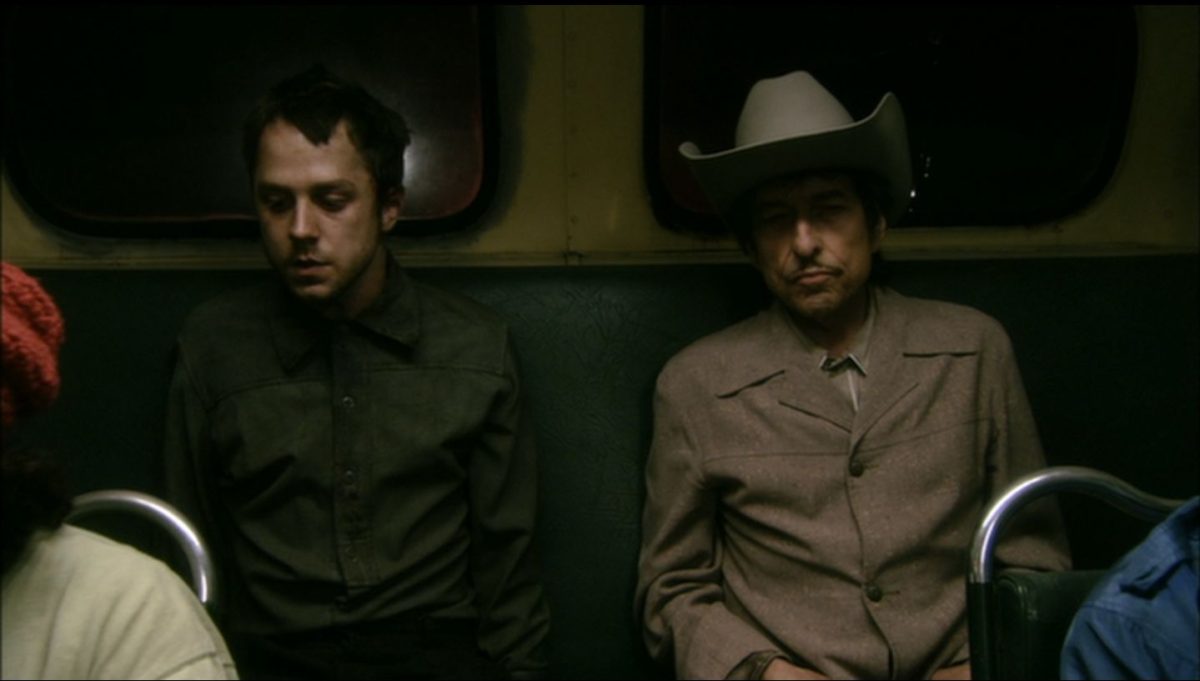
In looking at how the film envisions its characters and their temporal orientations, again, Chronicles offers something of an alternate perspective on what we are seeing in Masked and Anonymous. The film features many analogies to the American Civil War. Fate’s band performs a chipper rendition of “Dixie” and Luke Wilson’s character, Bobby Cupid, speaks like he were from the era, referencing Lee and Sherman and their preferred ways of dealing with enemies (“Lee would have shot him. Sherman would’ve hung him,” he reckons in reference to Tom Friend). Dylan, his band, and Bobby are often subtly associated, if not with the Civil War era directly, with a shared antiquiation. But beyond these surface references, there seems to be something else that Dylan was trying to evoke through these allusions. “In some ways, the [American] Civil War would be a battle between two kinds of time,” Dylan writes in Chronicles. “In the South, people lived their lives with sun-up, high noon, sunset, spring, summer. In the North, people lived by the clock. The factory stroke, whistles and bells. Abolition of slavery didn’t even seem to be an issue when the first shots were fired at Fort Sumter. It all makes you feel creepy. The age that I was living in didn’t resemble this age, but yet it did in some mysterious and traditional way.”
In this sense, Dylan uses Fate to layer scenes with different relationships to time and being in environments. Notice the contrasts between Dylan’s and Ribisi’s performances in the bus scene: As Ribisi speaks of his struggles to recognize his place in the current civil war and describes his reliance on dreams to shape his reality, he sits completely still in the constructed bus set, staring ahead and absorbed in the fantasy inside his head. Fate, who dismisses Ribisi’s escape into fantasy, sways lightly with the strange rhythm of the bus, as if it were actually in motion and not bound to a film set. This makes Fate at once more in-tune with the environment, and equally a part of the artifice of the filmmaking itself. Dylan strikes a mysterious balance in his performance that recognizes the unreality of the form and the strangeness of the reality of the scene, which isn’t as far removed from our own world as we may like to think.
Related: Face Value: Todd Haynes and The Velvet Underground (2021) by Brett Wright
Larry Charles specifically relates the episodic structure of Masked and Anonymous to “Highlands,” the seemingly endless closing track from Time Out of Mind. But another crucial comparison is the dark and gloomy “Political World,” which opens 1989’s Oh Mercy. Dylan has stated, “The political world in the song is more of an underworld, not the world where men live, toil and die like men.” But this notion of the political underworld in the song is far from a fantasy vision, and more our own world stripped of the shadows and the smoke to reveal just how elemental the funhouse mirrors of reality truly are. In Masked and Anonymous, there is still beauty in the world, but it is constantly being overwhelmed by the nightmares and deceptions of the social and political realm. When Hell quite literally makes its way to the surface towards the end of the film — a radio report announces that scientists have drilled a hole to Earth’s core, allowing a microphone to capture the voices of the damned — we are not shown mass reactions of shock and awe at the discovery, but an exhausted Nina Veronica, alone in her trailer, seemingly accepting the news as further confirmation of the despair already engulfing her existence.
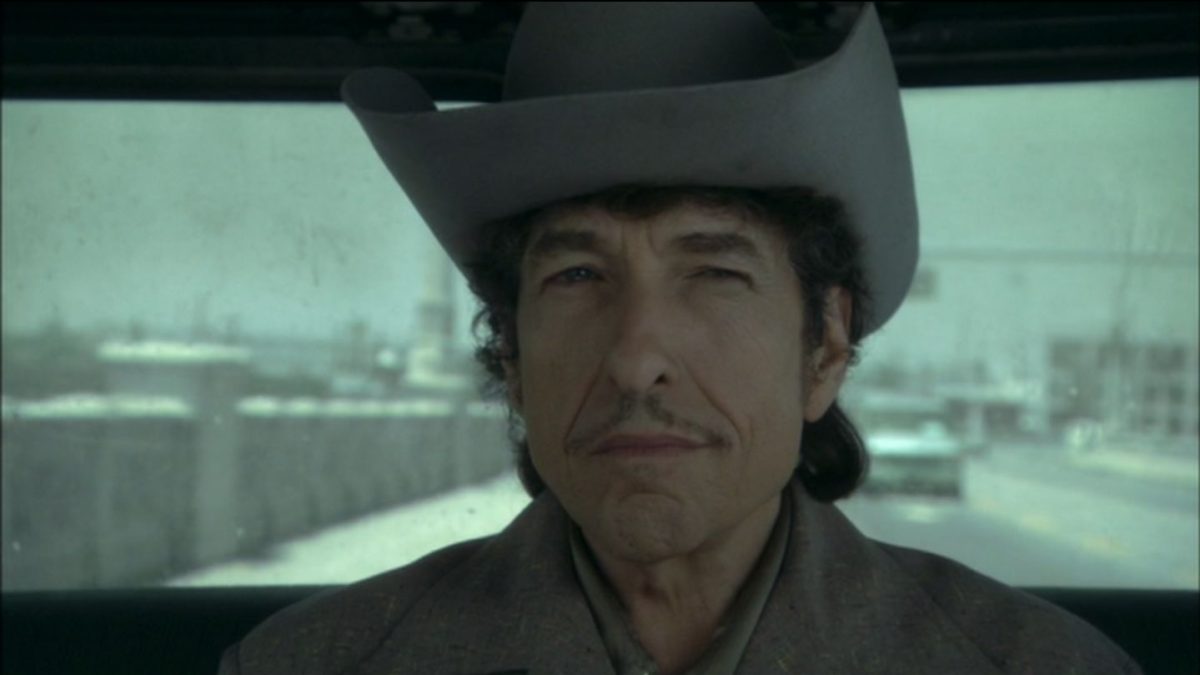
In his final moments on screen, Dylan, as Fate, tells us in a voice-over, “The way we look at the world is the way we really are. See it from a fair garden and everything looks cheerful. Climb to a higher plateau and you’ll see plunder and murder. Truth and beauty are in the eye of the beholder. I stopped trying to figure everything out a long time ago.” As he says this, a slowed down, live rendition of his early classic “Blowin’ in the Wind” plays. In Masked and Anonymous, Dylan demonstrates perhaps better than in any of his songs, the struggles and the dangers of trying to live by his own words of he who isn’t “busy being born is busy dying.” As Fate passes through a world of individuals whose identities have been frozen into caricatures and marbled over into relics by the atmosphere of the times, Masked and Anonymous shows that one must learn the rules of the system, but you’re damned if you try to really understand it or fix it. It’s a losing game and one that almost certainly ends in madness. Masked and Anonymous explores a darkly prophetic and universal truth about human nature: there’s just something about us that won’t let us get out of our own way. Our journey together will forever be cast upon that ship on its passage out.
Stream Masked and Anonymous on Amazon Prime
Stay up to date with all things Split Tooth Media and follow Brett on Twitter and Letterboxd
(Split Tooth may earn a commission from purchases made through affiliate links on our site.)
- It should also be mentioned that “Love and Theft” deserves to be recognized in tandem with Chronicles and Masked, but due to time and this piece already being long enough, I have mostly left it out of the discussion here. But you can see specific connections being drawn, for instance, to the Thucydides passage above in lyrics like “”You can’t open your mind, boys/To every conceivable point of view” in “High Water (for Charley Patton).”

